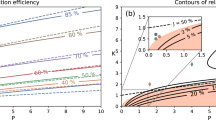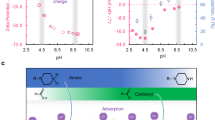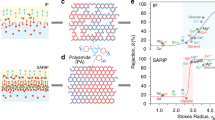Abstract
We describe a new class of membrane that has the capability of removing particles such as viruses from solution with resolution and reproducibility superior to that of conventional membranes. This composite membrane is composed of a pre-formed microporous membrane plus a thin asymmetric, finely porous retentive layer that is quite different from conventional ultrafilters. The protein sieving characteristics of this membrane are nearly equivalent to, but slightly less than, that of conventional 100,000 Dalton cut-off ultrafiltration membranes. This membrane uniquely shows particle retention characteristics that increase monotonically from 3 to 8 logs as a function of particle diameter in the range of 28 to 93 nm. The performance of this membrane in both a single stage and a two stage system show that 4 to 6 log overall removal of virus particles in the size range 30 to 70 nm is possible with simultaneous high recovery of product protein. Clearance factors exceeding 6 logs are possible with viruses larger than 78 nm. In addition, the performance of process systems containing this membrane is predictable in accordance with the general membrane properties and equilibrium mass balance models. This membrane system is fully validatable and can be used in conjunction with other validated operations in a downstream process to reliably achieve an overall reduction of 12 logs of known or putative virus particles.
This is a preview of subscription content, access via your institution
Access options
Subscribe to this journal
Receive 12 print issues and online access
$209.00 per year
only $17.42 per issue
Buy this article
- Purchase on Springer Link
- Instant access to full article PDF
Prices may be subject to local taxes which are calculated during checkout
Similar content being viewed by others
References
Lubiniecki, A.S. 1988. Safety of recombinant biologics: Issues and emerging answers, p. 3: 3–12. In: Animal Cell Biotechnology, Spier, R.E. and Griffiths, J.B. (Eds.). Academic Press, London, UK.
Petricciani, J.C. 1985. Regulatory considerations for products derived from the new biotechnology. Pharmaceut. Manufac. 5: 31–34.
Builder, S., van Reis, R., Paoni, N., Ogez, J. 1989. Process development and regulatory approval of tissue-type plasminogen activator, In: Advances in Animal Cell Biology and Technology for Bioprocesses. Spier, R.E., Griffiths, J.B., Stephenne, J., Crooy, P.J. (Eds.). Butterworths, Stoneham, MA. 452–464.
Division of Blood and Blood Products, U. S. Food and Drug Administration. 1984. Points to consider in the characterization of cell lines used to produce biologicals.
Office of Biologicals Research and Review, U. S. Food and Drug Administration. 1985. Points to consider in the production and testing of new drugs and biologicals by recombinant DNA technology.
Eshkol, A., Maillard, F. and Stiles, G. 1988. Purification of biological fluid by filtration through ultrafiltration membrane. European Patent No. EP0307373A2.
Wiebe, M., Becker, F., Lazar, L., May, L., Casto, B., Semense, M., Fautz, C., Garnick, C., Miller, C., Masover, G., Bergmann, D. and Lubiniecki, A.S. 1989. A multifaceted approach to assure that recombinant tPA is free of adventitious virus, p. 68–71. In: Advances in Animal Cell Biology and Technology for Bioprocesses. Op. cit.
Lubiniecki, A.L. and May, L.H. 1984. Cell bank characterization for recombinant DNA mammalian cell lines. Develop. Biol. Standard. 60: 141–146.
Pocchiari, M., Macchi, G., Peano, S. and Conz, A. 1988. Can potential hazard of Creutzfeld-Jacob disease infectivity be reduced in the production of human growth hormone. Arch. Virol. 98: 131–135.
Bechtel, M. K., Bagdasarian, A., Olson, W.P. and Estep, T.N. 1988. Virus removal or inactivation in hemoglobin solutions by ultrafiltration or detergent/solvent treatment. Biomat., Art. Cells, Art. Org. 16: 123–128.
Horowitz, B., Wiebe, M.E., Lippin, A. and Stryker, M.H. 1985 Inactivation of viruses in labile blood derivatives. Transfusion 25: 516–522.
Microbiological Associates, Inc. 1988. Evaluation of removal of simian virus 40 from human growth hormone by PTHK membrane purification process, In: Validation of Ares Serono Pharmaceutical Production, Ares-Serono S.A. Switzerland. 1: 41.
Prince, A.M., Stephen, W. and Brotman, B. 1984. Beta-propiolactone/UV irradiation: A review of its effectiveness Rev. of Inf. Diseases. 5: 92–107.
HyClone Laboratories, Inc. 1989. Greater retention of contaminants in fetal bovine serum: 40 nm filtration. Art to Science 2: 1–4.
Zeman, L. and Wales, M. 1981. Polymer solute rejection by ultrafiltration membranes, In: Synthetic Membranes, Vol II. A. F. Turbak (Ed.) Am. Chem. Soc., Washington, DC. 2: 411.
Kassotis, J.S., Shmidt, J., Hodgins, L.T. and Gregor, H.P. 1985. Modelling of the pore size distribution of ultrafiltration membranes. J. Memb. Sci. 22: 61–76.
Steuck, M.J. Porous membrane having hydrophilic surface and process. US Patent 4,618,533.
DiLeo, A.J., Allegrezza, A.E. Jr. and Burke, E.T. 1991. Membrane, process and system for isolating virus from solution. US Patent 5017292.
Pitt, A. 1987. The non-specific binding of polymeric microporous membranes. J. Parenteral Sci. and Techn. 41: 110–113.
Fasman, G. (Ed.). 1976. Handbook of Biochemistry and Molecular Biology, 3rd Ed. CRC Press, Boca Raton, FL. 242
Bird, R.B., Stewart, W.E. and Lightfoot, E.N., 1960. Transport Phenomena, John Wiley and Sons, Inc., NY. 514.
Millipore Corporation. 1988. An introduction to protein processing by tangential flow filtration. Process Systems Technical Brief, TB032.
McCabe, W.L. and Smith, J.C. 1967. Equilibrium staged operations, In: Unit Operations of Chemical Engineering, Second Ed. McGraw-Hill Book Co., NY, NY. 528–530.
Merck Index, Tenth Ed., Martha Windholz Ed. Merck & Co., Inc., Rahway, NJ.1239.
Willingmann, P., Krishnaswamy, S., McKenna, R., Smith, T.J., Olson, N.H., Rossmann, M.G., Stow, P.L. and Incardona, N.L. 1983. Preliminary investigation of the phage φX174 crystal structure. J. Mol. Biol. 212: 345–350. 1990.
Vidaver, A.K., Koski, R.K. and van Etten, J.L. 1973. Bacteriophage φ6: A lipid-containing virus of Pseudomonas phaseolicola J. Virology 11: 799–805.
Ellis, L.F. and Schlegel, R.A. 1974. Electron microscopy of Pseudomonas φ6 bacteriophage. J. Virology 14: 1547–1551.
Author information
Authors and Affiliations
Rights and permissions
About this article
Cite this article
DiLeo, A., Allegrezza, A. & Builder, S. High Resolution Removal of Virus from Protein Solutions Using a Membrane of Unique Structure. Nat Biotechnol 10, 182–188 (1992). https://doi.org/10.1038/nbt0292-182
Issue Date:
DOI: https://doi.org/10.1038/nbt0292-182



